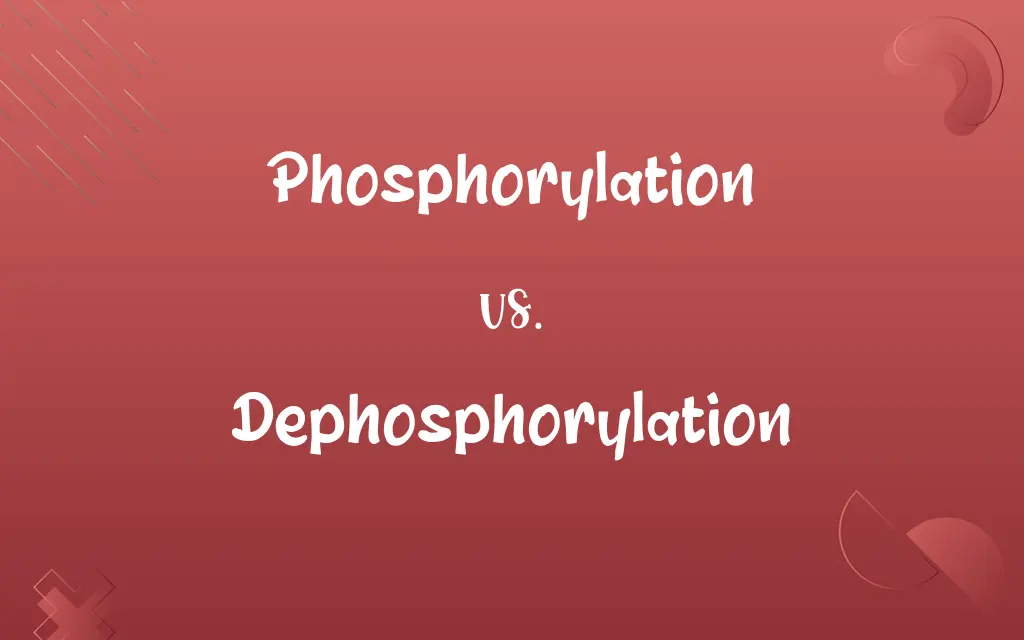Phosphorylation vs. Dephosphorylation: Know the Difference

By Hifza Nasir & Shumaila Saeed || Published on May 16, 2024
Phosphorylation adds a phosphate group to a molecule, enhancing activity or changing function, while dephosphorylation removes it, often reversing these effects.

Key Differences
Phosphorylation and dephosphorylation are critical for cellular signaling and regulatory mechanisms. Phosphorylation, the addition of a phosphate group to a protein or other organic molecule, often changes the molecule's function and activity, enabling cellular responses to external signals. Dephosphorylation, conversely, involves the removal of this phosphate group, often deactivating or altering the function of the molecule in the process.
Hifza Nasir
May 16, 2024
These processes are mediated by specific enzymes: kinases for phosphorylation and phosphatases for dephosphorylation. Kinases catalyze the transfer of a phosphate group from ATP to a substrate, modifying the substrate's structure and function. Phosphatases remove these phosphate groups, which can return the substrate to its original state or alter its activity differently.
Shumaila Saeed
May 16, 2024
Phosphorylation can activate or deactivate enzymes, change cellular locations of proteins, and alter substrate affinity, thus playing a key role in cellular signaling pathways. Dephosphorylation counteracts or complements these effects, thereby serving as a crucial mechanism for turning off signals or making proteins return to their inactive states.
Hifza Nasir
May 16, 2024
The dynamic balance between phosphorylation and dephosphorylation controls many cellular processes, including metabolism, cell cycle progression, and apoptosis. Disruptions in these processes can lead to diseases, such as cancer, where deregulated phosphorylation or dephosphorylation contributes to uncontrolled cell growth and division.
Shumaila Saeed
May 16, 2024
Both phosphorylation and dephosphorylation are reversible post-translational modifications, allowing cells to rapidly respond to changing environmental conditions or internal signals. This reversibility is vital for the dynamic regulation of cellular functions and for the integration of multiple signaling pathways.
Dua Fatima
May 16, 2024
ADVERTISEMENT
Comparison Chart
Common Outcome
Activation/deactivation, functional change
Reversal of phosphorylation effects
Hifza Nasir
May 16, 2024
Role in Cellular Signaling
Often activates signaling pathways
Often deactivates or downregulates pathways
Hifza Nasir
May 16, 2024
Impact on Protein Function
Can alter enzyme activity, protein interaction, cellular location
Often returns proteins to their original state or alters activity
Shumaila Saeed
May 16, 2024
ADVERTISEMENT
Phosphorylation and Dephosphorylation Definitions
Phosphorylation
Plays a key role in activating signaling molecules.
Phosphorylation activates many proteins involved in cell division.
Hifza Nasir
Feb 27, 2024
Dephosphorylation
Essential for turning off signal transduction pathways.
Dephosphorylation is crucial for resetting cellular signals post-activation.
Shumaila Saeed
Feb 27, 2024
Phosphorylation
Mediated by kinases, it often triggers cellular responses.
The kinase-induced phosphorylation of a receptor initiates signal transduction.
Hifza Nasir
Feb 27, 2024
Dephosphorylation
Can return a protein to its original state.
Dephosphorylation of a nuclear protein may cause it to exit the nucleus.
Hifza Nasir
Feb 27, 2024
Phosphorylation
Can change a protein's function or location.
Phosphorylation may cause a protein to relocate to the nucleus.
Hifza Nasir
Feb 27, 2024
ADVERTISEMENT
Dephosphorylation
Allows cells to revert to a resting state.
After a signal is received, dephosphorylation helps cells return to baseline activity.
Dua Fatima
Feb 27, 2024
Phosphorylation
Reversible, allowing for dynamic regulation.
Phosphorylation status of a protein can rapidly change in response to signals.
Shumaila Saeed
Feb 27, 2024
Dephosphorylation
The removal of a phosphate group, often reversing activation.
Dephosphorylation deactivates certain signaling pathways.
Hifza Nasir
Feb 27, 2024
Phosphorylation
The process of adding a phosphate group to a molecule, enhancing its activity.
Phosphorylation of enzymes can activate metabolic pathways.
Shumaila Saeed
Feb 27, 2024
Dephosphorylation
Mediated by phosphatases, it downregulates activity.
A phosphatase can halt a metabolic pathway by dephosphorylating key enzymes.
Shumaila Saeed
Feb 27, 2024
Repeatedly Asked Queries
What is the main difference between phosphorylation and dephosphorylation?
Phosphorylation adds a phosphate group to molecules, often activating or modifying them, whereas dephosphorylation removes this group, usually reversing these effects.
Shumaila Saeed
May 16, 2024
Can phosphorylation affect the location of a protein within a cell?
Yes, phosphorylation can cause proteins to change locations, such as moving to the nucleus or other cellular compartments.
Dua Fatima
May 16, 2024
How do phosphorylation and dephosphorylation regulate cellular functions?
They act as on/off switches for various cellular processes, including metabolism, gene expression, and cell cycle progression, by altering the activity of proteins and enzymes.
Hifza Nasir
May 16, 2024
How is dephosphorylation involved in turning off cell signals?
By removing phosphate groups, dephosphorylation turns off signaling pathways, helping the cell to stop responding to a signal once it has been received.
Shumaila Saeed
May 16, 2024
What happens if phosphorylation or dephosphorylation is deregulated?
Deregulation can lead to diseases, including cancer, where abnormal cell growth is driven by faulty signaling pathways.
Shumaila Saeed
May 16, 2024
Are phosphorylation and dephosphorylation reversible processes?
Yes, both are reversible, allowing cells to rapidly respond to changes and maintain homeostasis.
Hifza Nasir
May 16, 2024
How do cells achieve a balance between phosphorylation and dephosphorylation?
Through the regulated activity of kinases and phosphatases, ensuring that signaling pathways are appropriately activated or deactivated as needed.
Hifza Nasir
May 16, 2024
What role does ATP play in phosphorylation?
ATP serves as the phosphate donor in phosphorylation, providing the phosphate group that is transferred to the substrate.
Dua Fatima
May 16, 2024
What is cross-talk in the context of phosphorylation and dephosphorylation?
Cross-talk refers to interactions between different signaling pathways, where phosphorylation and dephosphorylation events in one pathway affect another.
Shumaila Saeed
May 16, 2024
Which enzymes are responsible for phosphorylation and dephosphorylation?
Kinases perform phosphorylation, and phosphatases carry out dephosphorylation.
Shumaila Saeed
May 16, 2024
Is phosphorylation always activating?
Not always; while it often activates proteins, it can also deactivate them or alter their function in other ways.
Shumaila Saeed
May 16, 2024
Can phosphorylation affect the stability of proteins?
Yes, it can either stabilize or destabilize proteins, affecting their degradation rate.
Shumaila Saeed
May 16, 2024
What is the significance of substrate specificity in phosphorylation and dephosphorylation?
Specificity ensures that only target proteins are modified, allowing precise control over cellular processes.
Hifza Nasir
May 16, 2024
How do phosphorylation and dephosphorylation contribute to signal amplification?
Phosphorylation cascades can amplify signals, with one phosphorylated protein activating multiple downstream proteins.
Hifza Nasir
May 16, 2024
How do environmental stimuli influence phosphorylation and dephosphorylation?
External signals, such as hormones or stress, can trigger these processes, leading to cellular responses adapted to changing conditions.
Hifza Nasir
May 16, 2024
Share this page
Link for your blog / website
HTML
Link to share via messenger
About Author
Written by
Hifza NasirCo-written by
Shumaila SaeedShumaila Saeed, an expert content creator with 6 years of experience, specializes in distilling complex topics into easily digestible comparisons, shining a light on the nuances that both inform and educate readers with clarity and accuracy.









































































